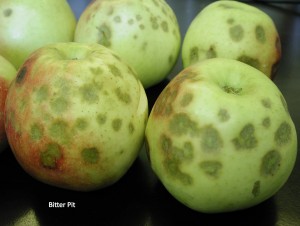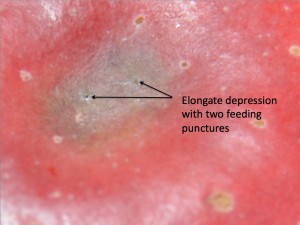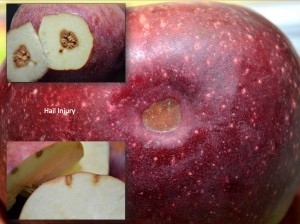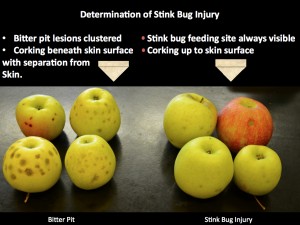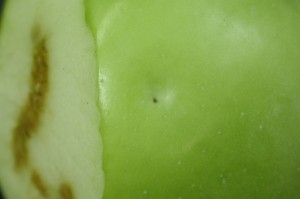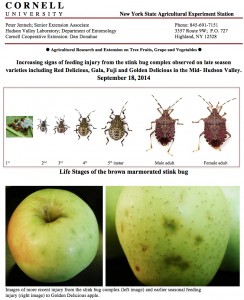
Over the past two weeks we have been seeing an increase in feeding injury from the invasive brown marmorated stink bug on red and yellow colored varieties. As injury does not express itself immediately on the fruit, apple recently fed upon by the SB complex will likely be harvested and stored without blemish, only to find the same fruit with very high levels of fruit damage after its removal from cold storage. Efforts should be made to manage this insect complex prior to harvest.
Trapping efforts throughout the Hudson Valley have documented the presence of brown marmorated stink bug since late April. However, its presence in border trees or even in traps has not, up until late August, been a sign of BMSB presence in orchards causing feeding damage. Ths BMSB has recently begun movement into orchards to intensively feed, stocking up on reserves needed to successfully overwinter. In orchards throughout the Hudson Valley we’ve captured what we would consider the ‘Provisional Threshold’ numbers of adult BMSB in pheromone trap captures over the course of the past two weeks. First threshold occurred on the 11th of September. Continued populations have been observed above the 10 adult per trap threshold, sprayed prior to trap reset with an effective insecticide.
Much confusion about injury can arise at harvest given the four types of late season injury that can occur to fruit. These are:
* Stink bug injury for three different species (Green, Brown and Brown Marmarated stink bugs)
A discolored depression.
Always a ‘sting’ site in the center of the depression.
Upon slicing, corking up to the skin surface.
* Hail injury during the season
A discolored depression.
Never a ‘sting’ site in the center of the depression.
Upon slicing, corking up to the skin surface.
* Bitter pit from calcium deficiency requiring applications throughout the season
A discolored depression.
Never a ‘sting’ site in the center of the depression.
Upon slicing, corking separated from the skin surface.
* Apple maggot from oviposition or egg laying site or ‘sting’ in fruit surface
Sometimes a depression. Most often only slight discoloration.
Always a ‘sting’ site in the center of the depression.
Upon slicing, no corking BUT soft, oxidized fruit flesh, often with tunneling well into the fruit.
Sting larger then SB feeding site, and always easy to see.
Cutting directly beneath the sting will give rise to juice seeping up from the egg laying sting.
See images related to injury below.
Trapping efforts throughout the Hudson Valley have documented the presence of brown marmorated stink bug since late April. However, its presence in border trees or even in traps has not, up until late August, been a sign of BMSB presence in orchards causing feeding damage. Ths BMSB has recently begun movement into orchards to intensively feed, stocking up on reserves needed to successfully overwinter. In orchards throughout the Hudson Valley we’ve captured what we would consider the ‘Provisional Threshold’ numbers of adult BMSB in pheromone trap captures over the course of the past two weeks. First threshold as of 11th of September and continued populations above the 10 adult per trap threshold, sprayed prior to trap reset with an effective insecticide.
Indications of stink bug presence can be observed in the presence of live SB in fruit clusters and harvested bins with examples of fruit injury of varieties remaining on the trees as is shown in the photos below. Control measures should be taken if this type of fruit injury is being observed. Very few insecticides are very effective against this insect complex with regards to residual efficacy. Those listed below are labeled for use against BMSB in NY and represent the best of university and USDA bioassay tested insecticides that will help to reduce the injury and increase mortality of the population. Consider using a non-ionic surfactant to increase penetration of the active ingredients. However, a tight schedule of no less than 7 days should be made if new fruit damage and stink bug adults continue. 